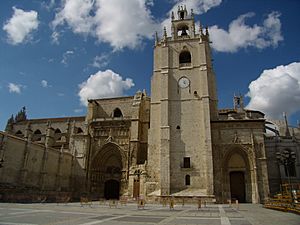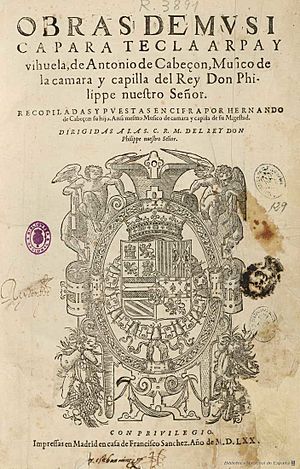Antonio de Cabezón facts for kids

Antonio de Cabezón (born March 30, 1510 – died March 26, 1566) was a famous Spanish Renaissance composer and organist. He became blind when he was very young. Despite this, he quickly became a skilled musician. He was later hired by the royal family. Cabezón was one of the most important composers of his time. He was also the first major keyboard composer from the Iberian region (Spain and Portugal).
Contents
Antonio de Cabezón's Life Story
Cabezón was born in Castrillo Mota de Judíos, a town near Burgos in northern Spain. We don't know much about his early childhood. He lost his sight when he was very young. He might have studied music at the Palencia Cathedral. The organist there, García de Baeza, may have been his teacher.
At this time, Spain was entering its Golden Age. This was a period of great art and culture. In 1516, Charles V became King of Castile and Aragon. This was the first time these two kingdoms were united under one king. Charles later inherited lands in Austria. He also became Emperor of the Holy Roman Empire. This made him one of the most powerful rulers in the world.
In 1525, Charles married Isabella of Portugal. This made his position in Spain even stronger. Isabella hired Cabezón to work for her in 1526. His jobs included playing the clavichord and the organ. He also became the organist for Isabella's chapel. Cabezón stayed with the royal family for the rest of his life.
At court, he met other important musicians. These included vihuelist Luis de Narváez. Narváez was known for his complex musical pieces called fantasias. He also met Tomás de Santa María. Santa María wrote an important book about instrumental music. Cabezón himself checked and approved this book.
In 1538, Cabezón became a "chamber musician" for Charles. After Isabella died in 1539, Cabezón taught music to her children. These included Prince Felipe and his sisters Maria and Joan. Maria later became a big supporter of the composer Tomás Luis de Victoria.
In 1543, Felipe became the ruler of Spain. He made Cabezón his court organist. Cabezón's job included playing a small portative organ for Felipe on his travels. Antonio and his brother Juan, who was also a musician, traveled with Felipe. They visited Italy, the Netherlands, Germany (in 1548–49), and England (in 1554–56). In England, Cabezón's musical variations might have influenced composers like William Byrd and Thomas Tallis.
We don't know much about Cabezón's personal life. He married Luisa Nuñez de Mocos from Ávila. They had five children. One of his sons, Hernando de Cabezón (1541–1602), also became a composer. Hernando worked hard to save most of Antonio's music. Another son, Agustín de Cabezón, sang in the royal chapel. Antonio de Cabezón died in Madrid on March 26, 1566.
Antonio de Cabezón's Music
Some of Cabezón's music was printed while he was alive. It appeared in a collection called Libro de cifra nueva (1557). But most of his music was published after he died. His son Hernando put it in a book called Obras de música para tecla, arpa y vihuela (1578).
These books contain about 275 pieces. Most of them are for organ or other keyboard instruments. Cabezón also wrote music for string instruments and groups. He wrote vocal music too. However, only one vocal piece survives. Many other works by him are likely lost. Cabezón was a great improviser on the keyboard. His son Hernando said that many of the works he wrote down were just "crumbs from my father's table."
Liturgical Organ Music
Cabezón wrote music for church services. This included music for the Mass and for the Daily Offices (daily prayers). He wrote nine sets of Kyrie verses for organ. These are short pieces played during the Kyrie part of the Mass.
He also wrote music for the Daily Offices. This includes 32 hymns. He also wrote three collections of short pieces called versets. These were for the psalms and for the Magnificats.
Tientos: A Special Musical Form
The tiento was a type of instrumental music. It started in Spain and Portugal. It was like an improvised introduction or a piece with imitation. Cabezón wrote 29 tientos that we still have today.
Many of his tientos use imitation. This is where different musical parts copy each other. They also have parts that are not imitative. Cabezón's later tientos used faster notes. They also had longer and more unique musical ideas. Many parts of these later pieces sound similar to music from the Baroque period.
Variations: Changing a Melody
Cabezón wrote nine sets of variations. In Spain, these were called discantes or diferencias. In variations, a main melody is repeated many times. Each time, it is changed in different ways.
Cabezón's variations are some of the earliest and best examples of this style. They probably influenced English composers like Thomas Tallis and William Byrd. His variations often start with the first change to the melody. This is because people were expected to already know the original tune. Cabezón used many different ways to change the melodies. He took ideas from popular Spanish songs, dances, and common musical patterns.
Intabulations: Music for Different Instruments
Intabulations are musical pieces that were originally for voices or other instruments. They were then rewritten for keyboard instruments. The intabulations in Obras de música are arranged by how complex they are. They start with simpler pieces for four parts. They end with more complex ones for six parts. These pieces are based on works by composers like Josquin des Prez and Orlande de Lassus.
Media
See also
 In Spanish: Antonio de Cabezón para niños
In Spanish: Antonio de Cabezón para niños






